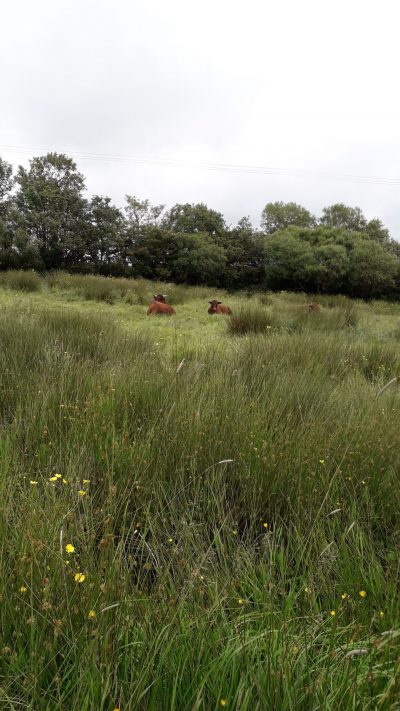The Bumpy Road to Success

"Things can and do change, and in thirty years we have seen huge shifts."
Pammy Riggs
A personal story of turning childhood farming dreams into reality, and taking the bumpy road into biodiversity gain.
Childhood dreams
My pride and joy as a child was my toy farm, what an easy child I must have been for birthdays and Christmas when adding another sheep, or cow to my toy farm was an easy gift to give. I remember looking down from my bed onto my toy farm and being so pleased that the carpet in my bedroom was green! When a friend came to stay, she brought her equivalent toy animals but horror of horror, she put a toy tiger down in the middle of my farm! I chucked it out across the room. It was an instinctive move! She collected zoo animals and I was interested only in farm animals. The most dangerous beast on my farm was a Jersey bull and I held him in awe and deep respect. That bulls were potentially dangerous, and Jersey bulls especially, had been drummed into me from an early age.
My family didn’t own a farm, but somehow I contrived to spend as much time as possible on other people’s farms, tagging along with Watt, a then 22 year old Scottish hill sheep farmer. Proudly, with my own sheep’s horn crook in hand I walked the flocks with him. Once he plonked me on the head of a ewe to lamb her, me acting as soothing ballast while he did his job. I must have slowed him down! But also acted as company, along with Hope and Glen the two speedy sheepdogs in his lonely life.
Early days
It was not until I met my husband-to-be, Ritchie, that this childhood farming dream became something of a reality.
Only organic, and the highest of welfare standards for either of us, not that we knew what either actually entailed! I had worked with horses and understood the responsibility of the 365/24 hour a day commitment. Ritchie feigned illness as a school boy then sneaked out to the local farm to help, gun toting, to scare pigeons off the seeds when ‘organic’ was not a ‘thing’ but just how farming was before chemical shortcuts crept in to become the norm.
Between us we were principled, idealistic but had no business experience at all, just a fierce desire to have our own kind of farm to feed decent food to our young family and being poor as church mice it would have to be from the ground up. Yes, we would have to build our own house too!
We started with the idea of ponies for me and goats for Ritchie. He did a Dairy goats City and Guilds Certificate, never have I seen a happier goatherd tramping the Devon lanes with his browsing flock, great fun but no chance of a business because the legislation around milk products and cheesemaking was way beyond our capabilities and our purse and there is only so much goat’s meat you can eat! It was fun while it lasted but impractical. Oh! the pony thing didn’t work out either except that I learnt to train a pony to pull a cart and that might still come in handy. (I have a secret desire to use a pony and trap or a goat cart to go shopping! And I still love goats and ponies), but back to the farming ideas.
We managed to procure 18 acres of wet Devon land, and were renting a home nearby, if The Dream were to happen, and our principles stay intact we needed a pretty special business and we really didn’t know how to do it?
The head scratching started! After ponies and goats we tried sheep and beef but on our small acreage it didn’t muster up the income we would need. Our sheep were good and when we sold several ewes with lambs at foot it gave us the capital needed to put our first organic chicken flock on the ground and a business was born.
Making it work
The thing is, we made it work and the best help was from surprising sources. Our local bank manager was amazing, he believed in us. A local councillor gave verbal encouragement that helped us believe in ourselves. A local farmer gave us advice and some of his tools and helped train our dog and another local farmer who was on the Planning Committee saw the need for a new generation of farming businesses and pledged his support. All in all, from a very shaky beginning we started to build a solid reputation. Our little organic farm was working, we negotiated the 2001 Foot and Mouth episode and opened our farm shop.

By this time, our organic pork and chicken was winning prizes. Social media had not taken off but the national press did the job of blowing our trumpet for us and the new-fangled internet created national demand. Farmers’ markets were beginning to be a trusted source of local food and these three together; shop, internet and market gave us the income we needed to build our house. Starting our little food business in earnest in November 1998 but with the vaguest idea and no business experience. We moved into our house in May 2004. Six years of dogged determination, 5 years in a caravan on the farm with teenagers! It was worth it.
During our thirty year tenure this little piece of Devon has changed dramatically. We bought one large 18 acre ryegrass, tractor-rutted field with silage wrap ground down into the mud and we turned it around.
Change does happen
Before Beeching’s axe did its job in the 1960s, the Bude-London railway ran across this land splitting it in half. The embankment had a standard British Railways brick arched tunnel connecting the lower and upper fields but the previous owner had pushed this out down the hill. One part was very steep and rocky and in 1991 we planted it up with trees, after a couple years of weeding they took off and now soar thirty feet overhead and are alive with wildlife as well as affording us a regular harvest of firewood and useful building materials.

Our restoration, possibly termed rewilding nowadays, continued by reducing fertility in the lower field over time, making life difficult for ryegrass which was shunted out by a wide variety of native plants. Taking a once a year cut of grass post seeding, we watched it slowly revert to the original habitat, Culm Measures as it is called in our area and the indicator species is the Marsh Fritillary butterfly. We have seen them and are fortunate to have contiguous wildlife friendly plots, a small stream, a tribute of the aptly named River Deer and bushy Devon hedges to join up the dots for wildlife.
Amazingly, from a desolate beginning we soon saw Devil’s Bit Scabious, Ragged Robin, plenty of vetches and sweet little plants, St George’s mushrooms in fairy rings, too much to mention. Of course the marshy rushes also appeared but you can’t have one without the other and with our low stocking density and Ruby Red cattle, indigenous to our part of Devon there was no problem feeding the species-rich but also rushes-rich silage. Termed ‘bed and breakfast’ by Ritchie we never have to buy straw for the cattle in winter and it all breaks down in a muck heap eventually. Even the native orchids appeared, first one, the following year four then exponentially over the next few years. Latterly they have diminished in number. I believe a definite symptom of climate change, our land is dryer and a Marsh Orchid likes to keep her feet wet.
Success and biodiversity
Things can and do change and in thirty years we have seen huge shifts. These hot August days have created thermals which stack soaring buzzards seven high above our land. Their young screech for attention and clumsily practising their flying. This small acreage is alive with food for them and the night flying bats and owls. Voles and grasshoppers, lizards, evidence of dormice in the hedgerows, regular frogspawn and toads, the odd hedgehog (not nearly enough for me) and a myriad of birds and that happened under our care.
Change is possible and Nature quick to take back what is rightfully hers if we will be thoughtful custodians. Meanwhile we still ran a profitable business alongside this.
The railway bed is now part of a national cycle and recreational path. This scheme started around 2009 and took a while to get off the ground, we were given a choice of fencing and thick hawthorn hedges were planted. Well before any public walked, ran, cycled or rode along it, our hedges were up and flourishing. We had priced up a similar single fence ourselves at £1000 so were thrilled to get a double wildlife corridor provided and all in favour of providing traffic free routes off the farm. We also gained the interesting sort of gateway crossing that opens into barriers. It pleases me, and still somehow has the feel of a railway level crossing.
Our very free-range organic poultry venture now on view to dog walkers was, contrary to our initial worries actually a boon. This constant stream of early to late movement meant attacks from foxes were lessened. A great relief!
This is only part of the story, but I hope it lets you know how possible it is to make changes and enjoy them too.

About the author: I’m Pammy, a farmer of many years who teachers courses, and writes about farming, animals, and much more!
